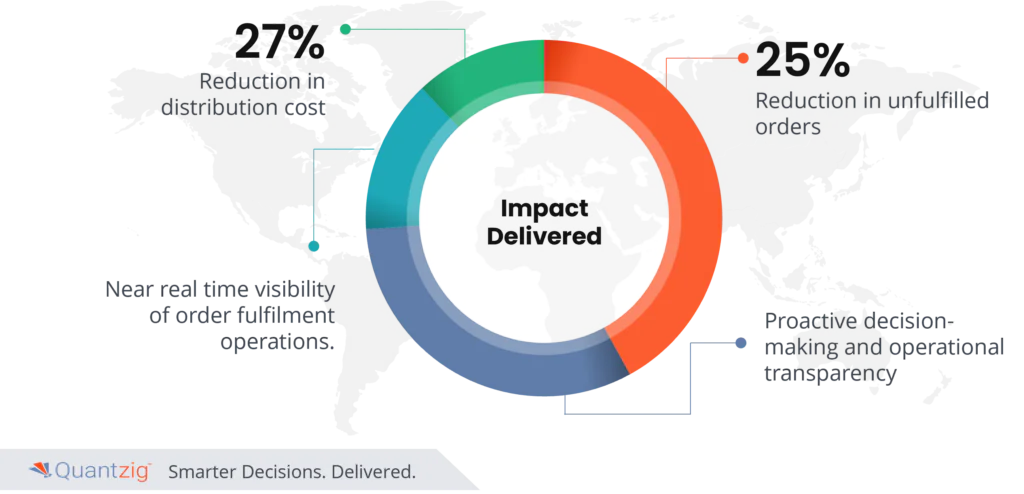Written By: Sudeshna Ghosh
Table of Contents
Key Takeaways
- A leading medical device manufacturer in US achieved 27% reduction in distribution cost, 25% reduction in unfulfilled orders, and near real time visibility of order fulfilment operations with the implementation of Quantzig’s a wholly integrated and seamless Order management System (OMS).
- The client was facing significant challenges with a huge network of manufacturing partners, 3PL vendors and outsourced warehouses.
- Quantzig provided solutions including data normalization, analytical dashboard development, transactional data visualization, cost-service trade-off evaluation, and what-if analyses for proactive decision-making.
- Implementing an OMS entails overcoming challenges such as complex data integration, customization for existing systems, and managing change effectively to ensure a seamless transition with minimal impact on business operations.
Introduction
E-commerce Order Management Systems (OMS) enable all the retailers to manage their all back-end processes of fulfilling online orders, ranging from purchase initiation to product delivery. Utilizing contemporary eCommerce order processing software, a modern OMS facilitates real-time inventory management, coordinates e-commerce sales via multiple channels, initiates fulfillment tasks, manages routing, prints shipping labels, and handles returns efficiently. This case study highlights how a leading medical device manufacturer achieved 27% reduction in distribution cost, 25% reduction in unfulfilled orders, and near real time visibility of order fulfilment operations with the implementation of Quantzig’s integrated and seamless Order management System (OMS).
Book a demo to experience the meaningful insights we derive from data through our analytical tools and platform capabilities. Schedule a demo today!
Request a Free DemoQuantzig’s Success Story
| Client Details | A leading medical device manufacturer in US |
| Challenges Faced by the Client | A huge network of manufacturing partners, 3PL vendors and outsourced warehouses |
| Solutions Offered by Quantzig | Data Normalization Mechanism, Analytical Dashboard Development, Transactional Data Visualization, Cost-Service Trade-off Evaluation, What-If Analyses. |
| Impact Delivered | 27% reduction in distribution cost, 25% reduction in unfulfilled orders, and near real time visibility of order fulfilment operations |
Client Details
Our client, a prominent medical device manufacturer based in the United States, boasts a vast customer base nationwide and commands revenues exceeding $5 billion.
Challenges Faced by the Client
- Despite their market dominance, our client encountered significant hurdles in managing their intricate network of manufacturing partners, 3PL vendors, and outsourced warehouses. This complexity led to difficulties in tracking various orders, resulting in prolonged time-to-market and operational inefficiencies.
- Compounded by prolonged product lifecycles and evolving customer demands, the client faced mounting pressure to optimize distribution across every node of their supply chains while ensuring traceability and sustainability from order confirmation to delivery. Moreover, managing reverse logistics had become increasingly intricate and costly, impeding effective demand management decisions.
Solutions Offered by Quantzig
- Data Normalization Mechanism: Quantzig devised a robust mechanism to normalize data sourced from diverse stakeholders, including 3PL vendors and manufacturing partners, streamlining information flow and enhancing data accuracy.
- Analytical Dashboard Development: Leveraging advanced analytics, our team developed a comprehensive dashboard solution. This empowered the client to seamlessly access and analyze critical information pertaining to orders, warehouses, customers, and shipments, fostering informed decision-making.
- Transactional Data Visualization: We provided the client with a coherent and multi-site view of transactional data, offering valuable insights into order flow across various customer segments and geographical regions.
- Cost-Service Trade-off Evaluation: Our experts evaluated cost-service trade-offs to ensure that customer requirements were addressed in a profitable manner, optimizing resource allocation and enhancing operational efficiency.
- What-If Analyses: Through advanced what-if analyses, Quantzig enabled the client to optimize transportation, inventory, and pricing strategies. This proactive approach empowered the client to anticipate and mitigate potential challenges, driving strategic decision-making.
Impact Delivered
The implementation of Quantzig’s tailored solutions yielded transformative results for our client:
- Achieved a remarkable 27% reduction in distribution costs, significantly enhancing operational profitability.
- Realized a notable 25% reduction in unfulfilled orders, mitigating risks associated with order fulfillment delays.
- Attained near real-time visibility of order fulfillment operations, facilitating proactive decision-making and operational transparency.
Through strategic collaboration with Quantzig, our client, a leading medical device manufacturer, successfully navigated the complexities of their supply chain landscape, achieving unprecedented levels of efficiency and operational excellence. With streamlined processes, enhanced visibility, and optimized resource allocation, our client is poised for sustained growth and continued success in the dynamic healthcare industry.
Quantzig’s Expert Solutions
- Quantzig offers cutting-edge solutions for ecommerce order management, ensuring seamless integration and optimization of the entire order management process. With our advanced Order Management System (OMS), businesses can efficiently handle multi-channel sales order management, streamline warehouse management, and enhance the fulfillment process for maximum customer satisfaction.
- Our comprehensive order management software utilizes business intelligence and forecasting accuracy to facilitate precise order promising and routing, resulting in improved order monitoring and fulfillment. Through effective customer communication and service, Quantzig’s solutions empower businesses to navigate the order journey with ease, ultimately driving customer satisfaction and loyalty. Partner with Quantzig to elevate your ecommerce sales and achieve unparalleled success in today’s competitive market landscape.
- Our advanced ecommerce order management system offers a real-time view on inventory, facilitating seamless management across various sales channels, including online stores, marketplaces like Amazon, and social media sites. From handling returns and subscription management to optimizing warehouse operations and fulfillment processes, our solution ensures efficient shipping and enhances competitiveness. Overcome challenges such as implementation and cost while prioritizing employee experiences and modern experiences. Stay ahead of the competition with streamlined direct to consumer brands integration, faster shipping speeds, and continuous innovation for unparalleled success in the dynamic ecommerce landscape.
Experience the advantages firsthand by testing a customized complimentary pilot designed to address your specific requirements. Pilot studies are non-committal in nature.
Request a Free PilotKey Features To Look For In An Ecommerce Order Management System
An advanced Order Management System (OMS) efficiently arranges and optimizes orders, employing business rules to determine optimal routing, forecast inventory requirements at designated fulfillment centers, and provide insights into valuable fulfillment options for customers.
For B2C enterprises considering the acquisition or utilization of an ecommerce order management system, here are essential features to prioritize:
1. Integration:
A robust OMS seamlessly integrates with existing systems, offering headless software with open APIs to facilitate smooth data flow and enable customizable workflows between user interfaces. Microservices-based OMS solutions provide flexibility, allowing multichannel retailers to tailor functionalities according to current needs and scale up as business demands evolve, thus future-proofing operations.
2. Ease of Use:
The ideal OMS aligns with existing technology infrastructure while ensuring user-friendliness across all organizational levels. Intuitiveness is paramount, empowering retail and marketing teams to effortlessly configure workflows, introduce new fulfillment options, and adapt promotional strategies without requiring extensive technical expertise.
3. Automation:
Advanced ecommerce OMS platforms empower retailers to implement automated processes, driving cost savings, error reduction, and heightened productivity. Automation of fulfillment tasks such as order rerouting expedites order fulfillment, leading to improved customer satisfaction through faster order delivery.
4. Inventory Management:
A comprehensive OMS includes robust inventory forecasting, reporting, and automated reordering functionalities. Real-time visibility into inventory levels enables smooth supply chain operations and enhances order processing efficiency. Centralized inventory management via the OMS streamlines stock replenishment processes, optimizing operations through enhanced connectivity.
5. Omnichannel Capabilities:
A modern OMS enables seamless ecommerce order management across multiple channels by consolidating customer information and inventory data in a centralized repository. Serving as a unified interface, the OMS empowers staff to efficiently handle orders originating from various sources, both online and in-store. Simplified training processes and reduced error rates are additional benefits, facilitated by automation and centralized management within a singular system.
6. Multichannel Order Management
In the Ecommerce Order Management, one pivotal feature to prioritize is Multichannel Order Management. This feature empowers businesses to efficiently handle orders originating from various sales channels, such as online stores, marketplaces, and social media platforms. By seamlessly integrating and managing orders across multiple channels, including E-commerce sales, companies can streamline their order management process and ensure efficient order routing.
With enhanced visibility and control over the entire order fulfillment process, from purchase order to delivery, businesses can effectively monitor orders, optimize warehouse management, and deliver superior customer service and customer communication. Through accurate forecasting and precise order promising, companies can enhance customer satisfaction and achieve seamless order fulfillment. This comprehensive approach, facilitated by advanced Order Management Systems and order management software, enables businesses to excel in the dynamic landscape of modern Ecommerce.
7. Scalable Cloud-Based Multichannel Order Management:
Experience streamlined order processing across various sales channels with an advanced ecommerce order management system. Benefit from real-time order monitoring and precise forecasting accuracy, ensuring reliable order promising and efficient multi-channel sales order management. This solution addresses stock needs, enhances warehouse optimization, and tracking inventory with unmatched scalability and a robust SaaS infrastructure. Leveraging cloud-based operations, gain instant insights into inventory control and forecast replenishment needs effortlessly. With extensible integration capability, streamline delivery capacity and multi-channel sales management, adapting to future trends seamlessly. Personalize orders effortlessly while integrating with ERPs, legacy systems, and operational technology for enhanced efficiency and seamless integration.
In essence, investing in a comprehensive ecommerce OMS equipped with these essential features ensures that B2C businesses can effectively navigate the complexities of modern commerce, enhance operational efficiency, and deliver exceptional customer experiences across all touchpoints.
Experience seamless oversight of orders across various sales channels with Quantzig’s comprehensive ecommerce order management system. Benefit from real-time data monitoring capabilities, ensuring forecasting accuracy and order promise adherence. Our solution facilitates streamlined management of sales orders, optimizing warehouse operations and maximizing multichannel opportunities for international service expansion. With precise tracking of inventory and order journeys, coupled with insightful business intelligence, achieve unparalleled efficiency in omnichannel selling and shipping services. Trust our solution to enhance your order management process, empowering your business for success in today’s dynamic market landscape.
Get started with your complimentary trial today and delve into our platform without any obligations. Explore our wide range of customized, consumption driven analytical solutions services built across the analytical maturity levels.
Start your Free Trial TodayHow Does E-commerce Order Management Work?
Effectively managing e-commerce orders entails optimizing the order routing and fulfillment process while minimizing errors. The typical workflow includes various steps:
- Initiation: Customers place orders online via the company website or third-party e-commerce platforms.
- Order Acceptance: The business logs and confirms the purchase order, either manually or through specialized ecommerce order or inventory management software.
- Customer Communication: Customers receive email confirmations of their order receipt and payment processing, along with estimated delivery times or order status tracking links.
- Sales Order Generation: A sales order is generated, and items are allocated from the company’s inventory, a process that can be manual or automated through Order Management System (OMS) functionality.
- Warehouse Processing: Order details are forwarded to the company’s warehouse, where stock levels are verified, and items are picked, packaged, and dispatched by the warehouse team.
- Dispatch Notification: Customers receive notifications of order dispatch, including tracking information if available. Simultaneously, the company monitors inventory levels and may initiate restocking activities with suppliers.
- Delivery and Satisfaction: Customers receive their purchases, and satisfaction checks are conducted to ensure a positive experience.
- Issue Resolution (if applicable): In cases where issues arise, customers may contact the business through various channels, such as email or social media. Resolutions may involve providing replacements, issuing refunds, or offering alternative solutions, with careful consideration of inventory and financial implications.
- Customer Feedback: Upon successful order completion, companies may solicit customer reviews to gauge satisfaction levels and improve customer service quality.
By adhering to these steps, businesses can efficiently manage e-commerce orders, enhance customer experiences, and foster long-term relationships.
Read more: Building an Effective e-Commerce Business Strategy with the Help of Web Mining and Text Analytics
How Does E-commerce Order Management Work?
In the dynamic landscape of Ecommerce, effective order management is paramount to ensure seamless operations and unparalleled customer experiences. From processing purchase orders to orchestrating the order fulfillment process, every step plays a crucial role in satisfying customer expectations.
Through robust order monitoring and multi-channel sales order management, businesses can gain invaluable insights into the order journey, optimizing processes to enhance efficiency and accuracy. With the exponential growth of E-commerce sales, the need for efficient order management becomes even more pronounced, underscoring the importance of streamlined operations.
Moreover, customer service remains at the forefront of Ecommerce success, with responsive communication and personalized experiences driving customer satisfaction. Therefore, investing in comprehensive Ecommerce order management solutions is essential to navigate the complexities of modern commerce effectively and stay ahead in today’s competitive market landscape.
The primary objective of an order management system (OMS) is to ensure efficient product delivery to customers, overseeing each item’s journey from selection to receipt and any subsequent returns.
1. The Order Fulfillment Process:
Every company employs a distinct approach to fulfillment, encompassing factors such as customer preferences, fulfillment centers, return procedures, and supplier relationships. Although procedures may vary, typical fulfillment processes involve the following stages:
- Customer Order Receipt: The company receives an order from the customer.
- Order Entry: The order details are entered into the company’s system.
- Customer Notification: The customer is notified of the order receipt.
- Order Routing: The order is directed to the nearest warehouse or fulfillment center.
- Order Picking: An employee retrieves the ordered items from the inventory shelves.
- Order Preparation: The company prepares the order for shipment and generates shipping labels.
- Order Shipment: The order is dispatched for delivery.
- Customer Notification: The customer receives notification of the order’s shipment.
- Order Delivery: The order is received by the customer.
2. Role of Order Management Systems in Facilitating Order Fulfillment:
Order management systems play a crucial role in optimizing the fulfillment process, striving for efficiency, cost-effectiveness, and automation. These systems streamline various steps to minimize shipping expenses, enhance data and inventory accuracy, and optimize picking and packing procedures. Additionally, many OMS platforms offer functionalities for managing returns and processing credit card transactions. Premium operational software seamlessly integrates with leading e-commerce tools and platforms, adapting to the unique requirements of each business.
Upon customer payment, the OMS may update accounting systems, generate invoices, and produce shipping labels. Furthermore, during the shipment phase, e-commerce order management software integrates with Third-party logistics (3PL), Fulfillment by Amazon (FBA), or shipping carriers such as FedEx or DHL to track order progress. This end-to-end visibility enables customers to monitor their orders until they reach their doorstep, often facilitated by the OMS itself.
What Processes do Order Management Systems help automate?
Order Management Systems play a pivotal role in facilitating every stage of your product fulfillment journey. They offer support in various essential areas:
- Managing orders from diverse channels, including your own online store, marketplaces, bulk orders, and reseller transactions.
- Providing real-time insights into product availability and inventory levels.
- Determining the optimal warehouse management for order fulfillment.
- Tracking the status of customer orders efficiently.
- Synchronizing customer order data seamlessly with your CRM system.
- Integrating with accounting tools to aid in financial forecasting.
Robust Order Management software contributes significantly to essential business processes and tasks, ensuring synchronization across all operations and enabling you to consistently meet customer expectations.
Why Streamline your E-commerce Order Management System?
In today’s competitive landscape, customers anticipate a personalized and seamless shopping journey with each interaction on your website and every order they place.
Consistency is key; if a customer enjoyed next-day delivery on their initial purchase, they’ll naturally expect the same level of service on subsequent orders.
As your business expands, maintaining efficient systems becomes paramount. Any discrepancies, such as low inventory impacting delivery times, must be promptly addressed to avoid disappointing customers with outdated shipping estimates.
Streamlined processes are crucial to delivering exceptional service. Inefficient operations can result in gaps in the customer experience, leading to dissatisfaction and putting your team in a perpetual cycle of playing catch-up.
To scale effectively and sustainably, modern ecommerce enterprises require an advanced order management system. By automating manual tasks, you’ll save valuable time and empower your team to focus on strategic initiatives, resolving intricate customer issues, and positioning your company for continued growth.
Conclusion
In conclusion, the adoption of a robust Order Management System (OMS) emerges as indispensable for modern e-commerce enterprises aiming to excel in the competitive digital landscape. The case study featuring a leading medical device manufacturer in the US, empowered by Quantzig’s integrated OMS, underscores the tangible benefits achievable through streamlined order management process, including substantial cost reductions and enhanced operational visibility.
As highlighted throughout this study, key features such as integration, ease of use, automation, inventory management, and omnichannel capabilities are pivotal in ensuring seamless order processing and customer satisfaction. Moreover, the efficient automation and synchronization facilitated by OMS solutions not only optimize order fulfillment but also empower businesses to scale effectively while maintaining consistent service standards. By embracing advanced OMS functionalities, e-commerce companies can navigate complexities, deliver exceptional customer experiences, and position themselves for sustained growth in the ever-evolving digital landscape.




